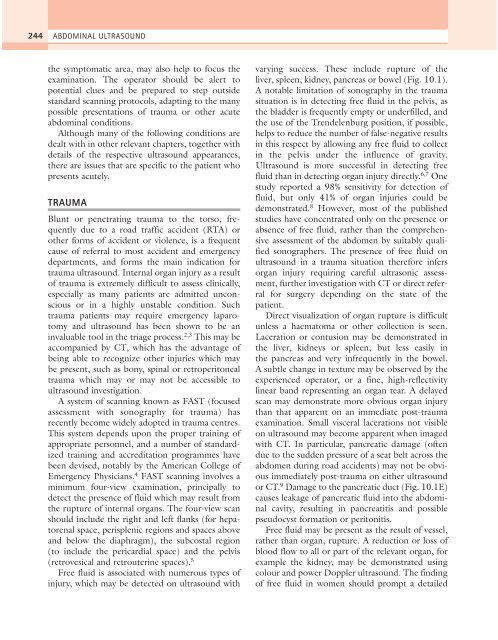9%20ECOGRAFIA%20ABDOMINAL%20COMO%20CUANDO%20DONDE
You also want an ePaper? Increase the reach of your titles
YUMPU automatically turns print PDFs into web optimized ePapers that Google loves.
244<br />
ABDOMINAL ULTRASOUND<br />
the symptomatic area, may also help to focus the<br />
examination. The operator should be alert to<br />
potential clues and be prepared to step outside<br />
standard scanning protocols, adapting to the many<br />
possible presentations of trauma or other acute<br />
abdominal conditions.<br />
Although many of the following conditions are<br />
dealt with in other relevant chapters, together with<br />
details of the respective ultrasound appearances,<br />
there are issues that are specific to the patient who<br />
presents acutely.<br />
TRAUMA<br />
Blunt or penetrating trauma to the torso, frequently<br />
due to a road traffic accident (RTA) or<br />
other forms of accident or violence, is a frequent<br />
cause of referral to most accident and emergency<br />
departments, and forms the main indication for<br />
trauma ultrasound. Internal organ injury as a result<br />
of trauma is extremely difficult to assess clinically,<br />
especially as many patients are admitted unconscious<br />
or in a highly unstable condition. Such<br />
trauma patients may require emergency laparotomy<br />
and ultrasound has been shown to be an<br />
invaluable tool in the triage process. 2,3 This may be<br />
accompanied by CT, which has the advantage of<br />
being able to recognize other injuries which may<br />
be present, such as bony, spinal or retroperitoneal<br />
trauma which may or may not be accessible to<br />
ultrasound investigation.<br />
A system of scanning known as FAST (focused<br />
assessment with sonography for trauma) has<br />
recently become widely adopted in trauma centres.<br />
This system depends upon the proper training of<br />
appropriate personnel, and a number of standardized<br />
training and accreditation programmes have<br />
been devised, notably by the American College of<br />
Emergency Physicians. 4 FAST scanning involves a<br />
minimum four-view examination, principally to<br />
detect the presence of fluid which may result from<br />
the rupture of internal organs. The four-view scan<br />
should include the right and left flanks (for hepatorenal<br />
space, perisplenic regions and spaces above<br />
and below the diaphragm), the subcostal region<br />
(to include the pericardial space) and the pelvis<br />
(retrovesical and retrouterine spaces). 5<br />
Free fluid is associated with numerous types of<br />
injury, which may be detected on ultrasound with<br />
varying success. These include rupture of the<br />
liver, spleen, kidney, pancreas or bowel (Fig. 10.1).<br />
A notable limitation of sonography in the trauma<br />
situation is in detecting free fluid in the pelvis, as<br />
the bladder is frequently empty or underfilled, and<br />
the use of the Trendelenburg position, if possible,<br />
helps to reduce the number of false-negative results<br />
in this respect by allowing any free fluid to collect<br />
in the pelvis under the influence of gravity.<br />
Ultrasound is more successful in detecting free<br />
fluid than in detecting organ injury directly. 6,7 One<br />
study reported a 98% sensitivity for detection of<br />
fluid, but only 41% of organ injuries could be<br />
demonstrated. 8 However, most of the published<br />
studies have concentrated only on the presence or<br />
absence of free fluid, rather than the comprehensive<br />
assessment of the abdomen by suitably qualified<br />
sonographers. The presence of free fluid on<br />
ultrasound in a trauma situation therefore infers<br />
organ injury requiring careful ultrasonic assessment,<br />
further investigation with CT or direct referral<br />
for surgery depending on the state of the<br />
patient.<br />
Direct visualization of organ rupture is difficult<br />
unless a haematoma or other collection is seen.<br />
Laceration or contusion may be demonstrated in<br />
the liver, kidneys or spleen, but less easily in<br />
the pancreas and very infrequently in the bowel.<br />
A subtle change in texture may be observed by the<br />
experienced operator, or a fine, high-reflectivity<br />
linear band representing an organ tear. A delayed<br />
scan may demonstrate more obvious organ injury<br />
than that apparent on an immediate post-trauma<br />
examination. Small visceral lacerations not visible<br />
on ultrasound may become apparent when imaged<br />
with CT. In particular, pancreatic damage (often<br />
due to the sudden pressure of a seat belt across the<br />
abdomen during road accidents) may not be obvious<br />
immediately post-trauma on either ultrasound<br />
or CT. 9 Damage to the pancreatic duct (Fig. 10.1E)<br />
causes leakage of pancreatic fluid into the abdominal<br />
cavity, resulting in pancreatitis and possible<br />
pseudocyst formation or peritonitis.<br />
Free fluid may be present as the result of vessel,<br />
rather than organ, rupture. A reduction or loss of<br />
blood flow to all or part of the relevant organ, for<br />
example the kidney, may be demonstrated using<br />
colour and power Doppler ultrasound. The finding<br />
of free fluid in women should prompt a detailed



